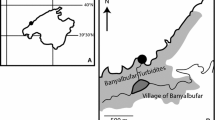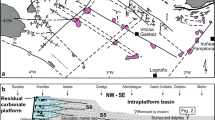Abstract
New observations from two late Precambrian (~800-650 Ma) sedimentary rhythmites in South Australia (Reynella Siltstone and Chambers Bluff Tillite) reveal cycles structurally similar to the ~12-laminae cycles of the ~650-Ma Elatina Formation but which comprise from 15 to 26 or more laminae. The new data are difficult to accomodate in depositional models for the Elatina Formation whereby its laminae are regarded as annual and the cyclicity ascribed to solar variability (Williams and Sonett, 1985) or to the combined influences of the sunspot cycle and the lunar nodal tide (Zahnle and Walker, 1987). If, however, the long-term ‘Elatina Cycle’ and not the individual lamina is taken as a yearly climatic signal, the Elatina and other rhythmites studied may be interpreted as the deposits of marine ebb-tidal deltas that record variability in the velocity and range of paleo-ebb tides. The basic laminae-cycles would represent lunar fortnightly cycles of diurnal and/or semidiurnal laminae, commonly truncated through non-deposition at neap tides. Despite numerous empirical similarities between the Elatina and sunspot series, the ebb-tidal model for deposition is preferred because it accounts plausibly for observations from all three rhythmites studied.
Similar content being viewed by others
References
Boothroyd, J. C.: 1985, ‘Tidal Inlets and Tidal Deltas’, in R. A. Davis, Coastal Sedimentary Environments, Springer-Verlag, New York, pp. 445–532.
Bracewell, R. N.: 1985, ‘Sunspot Number Series Envelope and Phase’, Aust. J. Phys. 38, 1009–1025.
Bracewell, R. N.: 1986, ‘Simulating the Sunspot Cycle’, Nature 323, 516–519.
Evans, J.: 1972, Tidal Growth Increments in the Cockle Clinocardium nuttalli, Science 176, 416–417.
Fitzgerald, D. M. and Nummedal, D.: 1983, ‘Response Characteristics of an Ebb-dominated Tidal Inlet Channel’, J. Sediment. Petrology 53, 833–845.
Lambeck, K.: 1980, The Earth's Variable Rotation: Geophysical Causes and Consequences, Cambridge University Press, Cambridge.
Noyes, R. W., Weiss, N. O., and Vaughan, A. H.: 1984, ‘The Relation Between Stellar Rotation Rate and Activity Cycle Periods’, Astrophys. J. 287, 769–773.
Özsoy, E.: 1986, ‘Ebb-tidal Jets: A Model of Suspended Sediment and Mass Transport at Tidal Inlets’, Estuarine, Coastal and Shelf Science 22, 45–62.
Pariwono, J. I., Bye, J. A. T., and Lennon, G. W.: 1986, ‘Long-period Variations of Sea-level in Australasia’, Geophys. J. Roy. Astron. Soc. 87, 43–54.
Preiss, W. V. (comp.): 1987, The Adelaide Geosyncline, Bull. 53, S. Aust. Dept. Mines and Energy, Adelaide.
Smith, N. D.: 1978, ‘Sedimentation Processes and Patterns in a Glacier-fed Lake with Low Sediment Input’, Canad. J. Earth. Sciences 15, 741–756.
Sonett, C. P. and Williams, G. E.: 1985, ‘Solar Periodicities Expressed in Varves from Glacial Skilak Lake, Southern Alaska’, J. Geophys. Res. 90, 12,019–12,026.
Sonett, C. P. and Williams, G. E.: 1987, ‘Frequency Modulation and Stochastic Variability of the Elatina Varve Record: A Proxy for Solar Cyclicity?’, Solar Phys. 110, 397–410.
van den Berg, J. H., de Boer, P. L., de Mowbray, T., Nio, S. D., Raven, H., Siegenthaler, C., Visser, M. J., and Yang, C. S.: 1983, Short Field Course. Clastic Tidal Deposits, Comparative Sedimentology Division, Institute of Earth Sciences, The University of Utrecht, The Netherlands.
Walker, J. C. G. and Zahnle, K. J.: 1986, ‘Lunar Nodal Tide and the Distance to the Moon During the Precambrian’, Nature 320, 600–602.
Williams, G. E.: 1981, ‘Sunspot Periods in the Late Precambrian Glacial Climate and Solar-Planetary Relations’, Nature 291, 624–628.
Williams, G. E.: 1985, ‘Solar Affinity of Sedimentary Cycles in the Late Precambrian Elatina Formation’, Aust. J. Phys. 38, 1027–1043.
Williams, G. E.: 1986, ‘Precambrian Permafrost Horizons as Indicators of Palaeoclimate’, Precambrian Res. 32, 233–242.
Williams, G. E.: 1987, ‘Cosmic Signals Laid Down in Stone’, New Scientist 114 (1566), 63–66.
Williams, G. E. and Sonett, C. P.: 1985, ‘Solar Signature in Sedimentary Cycles from the Late Precambrian Elatina Formation, Australia’, Nature 318, 523–527
Williams, G. E. and Tonkin, D. G.: 1985, ‘Periglacial Structures and Palaeoclimatic Significance of a Late Precambrian Blockfield in the Cattle Grid Copper Mine, Mount Gunson, South Australia’, Aust. J. Earth Sciences 32, 287–300.
Zahnle, K. J. and Walker, J. C. G.: 1987, ‘Climatic Oscillations During the Precambrian Era’, Climatic Change 10, 269–284.
Author information
Authors and Affiliations
Rights and permissions
About this article
Cite this article
Williams, G.E. Cyclicity in the late Precambrian Elatina Formation, South Australia: Solar or tidal signature?. Climatic Change 13, 117–128 (1988). https://doi.org/10.1007/BF00140565
Received:
Revised:
Issue Date:
DOI: https://doi.org/10.1007/BF00140565




